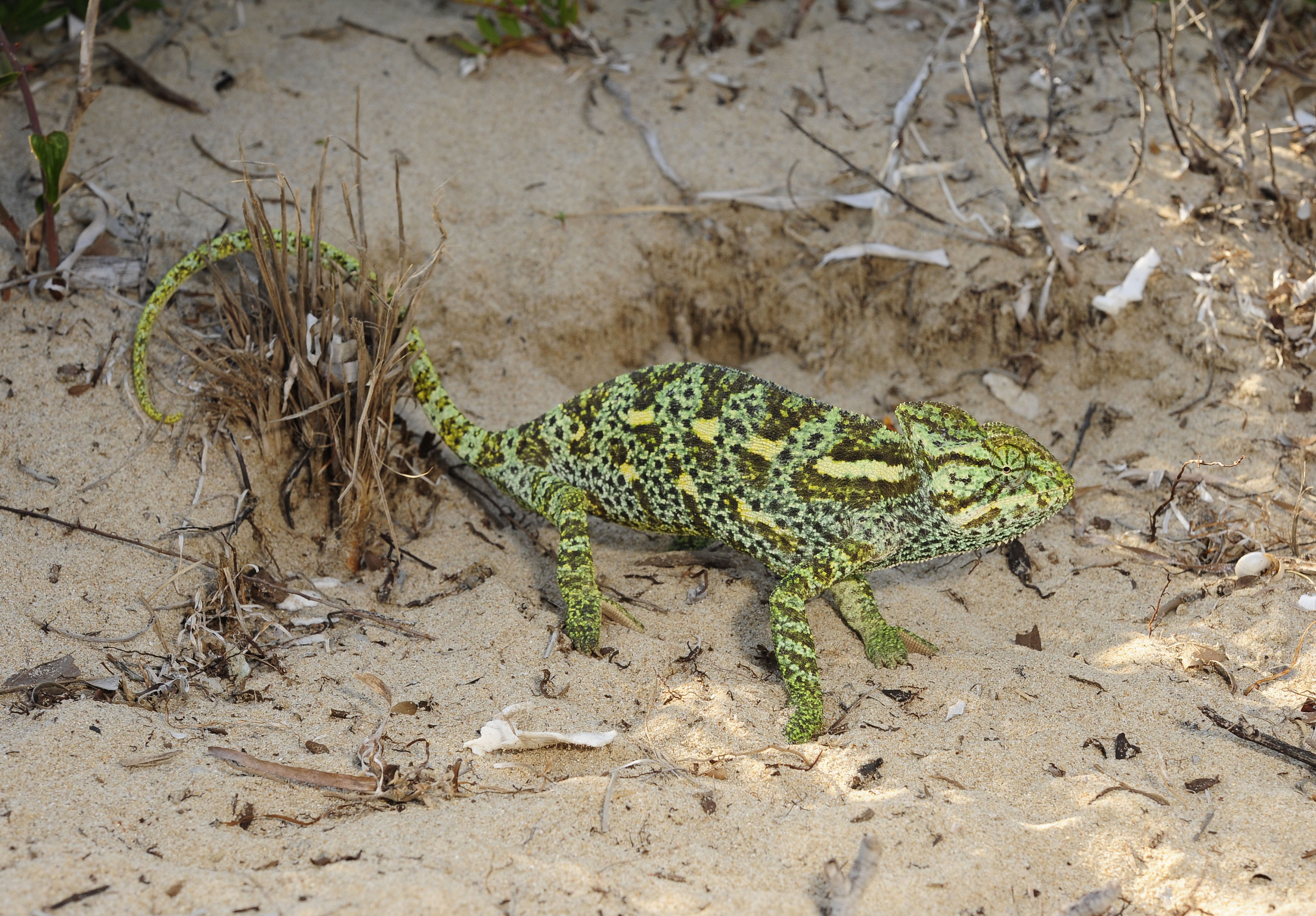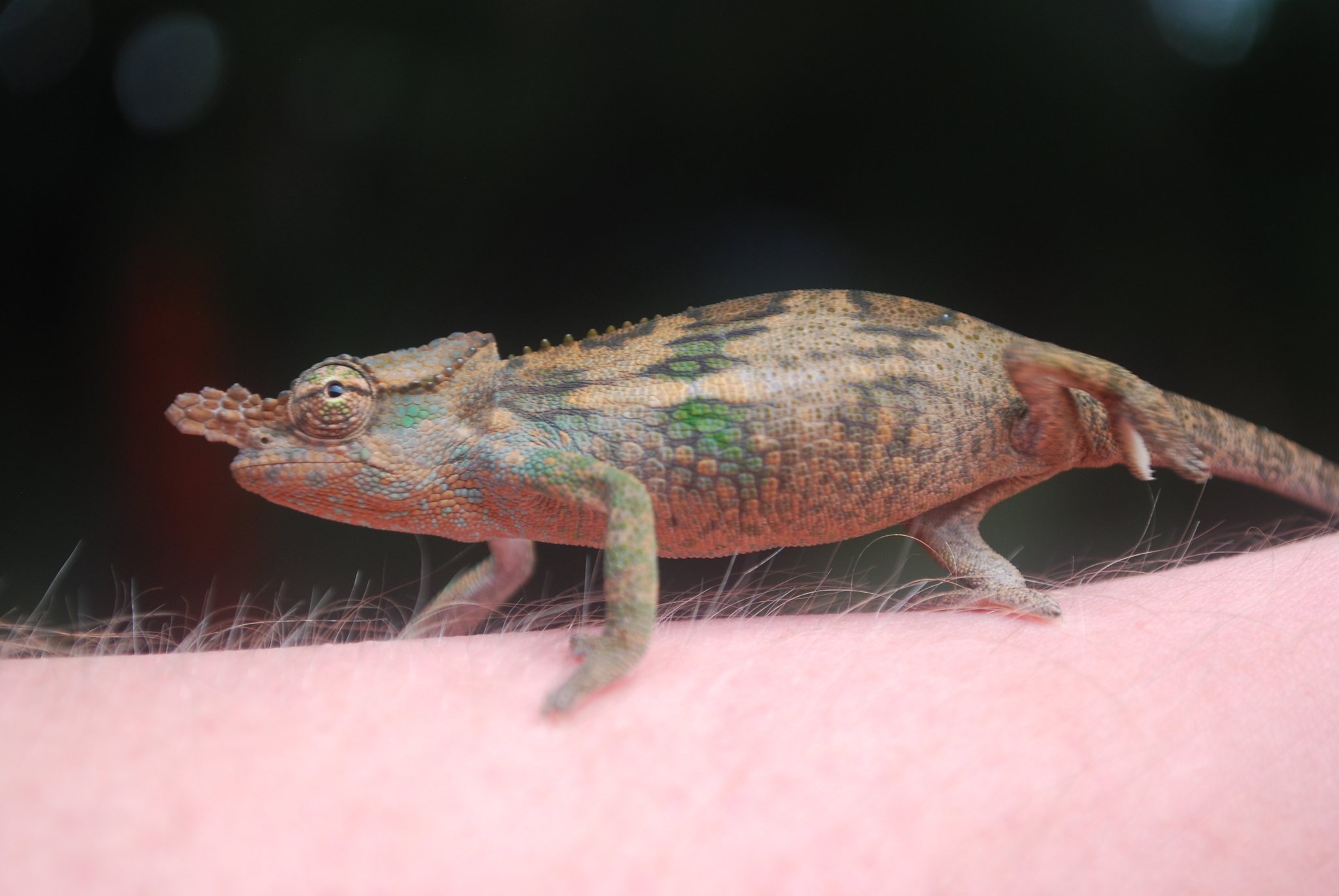|
Chamaeleoninae
Chamaeleoninae is the nominotypical subfamily of chameleons (family Chamaeleonidae). The Family Chamaeleonidae was divided into two subfamilies, Brookesiinae and Chamaeleoninae, by Klaver and Böhme in 1986. Since its erection in 1986, however, the validity of this subfamily designation has been the subject of much debate, although most phylogenetic studies support the notion that the pygmy chameleons of the subfamily Brookesiinae are not a monophyletic group. While some authorities have previously preferred to use the subfamilial classification on the basis of the absence of evidence principal, these authorities later abandoned this subfamilial division, no longer recognizing any subfamilies with the family Chamaeleonidae. In 2015, however, Glaw reworked the subfamilial division by placing only the genera '' Brookesia'' and '' Palleon'' within the Brookesiinae subfamily, with all other genera being placed in Chamaeleoninae. Classification The ten previously recognised genera in ... [...More Info...] [...Related Items...] OR: [Wikipedia] [Google] [Baidu] |
Brookesiinae
The Family Chamaeleonidae was divided into two subfamilies, Brookesiinae and Chamaeleoninae, by Klaver and Böhme in 1986. Under this classification, Brookesiinae included the genera '' Brookesia'' and ''Rhampholeon'', as well as the genera later split off from them ('' Palleon'' and '' Rieppeleon''). The Brookesiinae are small, often brown in colour, and occur in central Africa and Madagascar. They have terrestrial habits, or may be found in the lower levels of shrubs. Since its erection in 1986, however, the validity of this subfamily designation has been the subject of much debate, although most phylogenetic studies support the notion that the pygmy chameleons of the subfamily Brookesiinae are not a monophyletic In biological cladistics for the classification of organisms, monophyly is the condition of a taxonomic grouping being a clade – that is, a grouping of organisms which meets these criteria: # the grouping contains its own most recent co ... group. While so ... [...More Info...] [...Related Items...] OR: [Wikipedia] [Google] [Baidu] |
Chamaeleo
''Chamaeleo'' is a genus of chameleons in the Family (biology), family Chamaeleonidae. Most species of the genus ''Chamaeleo'' are found in sub-Saharan Africa, but a few species are also present in northern Africa, southern Europe, and southern Asia east to India and Sri Lanka. Description Species in the genus ''Chamaeleo'' are slow moving, with independently movable eyes, the ability to change skin colouration, a long tongue, usually a prehensile tail, and special leg adaptations for grasping vegetation. Males are generally larger and more colorful than females. Almost all species have a maximum snout-vent length (SVL) between . Behavior The vast majority of ''Chamaeleo'' species are arboreal and typically found in trees or bushes, but a few species (notably the Namaqua Chameleon) are partially or largely Terrestrial animal, terrestrial. Reproduction The genus ''Chamaeleo'' includes only Oviparity, oviparous species. In captivity With few exceptions, the chameleons most commo ... [...More Info...] [...Related Items...] OR: [Wikipedia] [Google] [Baidu] |
Perinet Chameleon
The Perinet chameleon (''Calumma gastrotaenia''), also known as the Malagasy side-striped chameleon, is a small species of chameleon endemic to humid primary forests, particularly along rivers, in eastern and central Madagascar at elevations between 600 and 1,530 m. It is listed on CITES CITES (shorter acronym for the Convention on International Trade in Endangered Species of Wild Fauna and Flora, also known as the Washington Convention) is a multilateral treaty to protect endangered plants and animals from the threats of inte ... Appendix II, and as such, trade in the Perinet chameleon is regulated. Exporting the species from Madagascar has been banned since 1995. Description Perinet chameleons are small and slender, reaching 15–20 cm, with elongated heads and bodies. They have smooth, uniformly green, brown or yellow skin with white undersides. A thin stripe runs from their tail bases along the sides of their bodies and across their eyes, and may include white spo ... [...More Info...] [...Related Items...] OR: [Wikipedia] [Google] [Baidu] |
Calumma
''Calumma'' is a genus of chameleons, highly adapted and specialised lizards, in the Family (biology), family Chamaeleonidae. The genus is endemic to the island of Madagascar. One species, formerly known as ''Calumma tigris'' (the Seychelles tiger chameleon), was transferred to the genus ''Archaius'' in 2010, upon the discovery of its closer relation to ''Rieppeleon''—one of several genera referred to collectively as "leaf" or "pygmy" chameleons—rather than to ''Calumma''. The earliest known fossil of the genus is of ''Calumma benovskyi'', from early Miocene Kenya, showing that the genus likely originated on mainland East Africa. The genus includes one of the heaviest and longest chameleon species, the Parson's chameleon (''Calumma parsonii''). Species groups Four species groups are recognised within the genus ''Calumma'' (originally proposed by Frank Glaw, Glaw & Miguel Vences, Vences in 1994), some of which may be only phenetic, while others are phylogenetically supported: ... [...More Info...] [...Related Items...] OR: [Wikipedia] [Google] [Baidu] |
Trioceros
''Trioceros'' is a genus of lizards in the family Chamaeleonidae, the chameleons, native to lowlands and highlands in the African mainland, ranging from Ethiopia south to Mozambique and west as far as Ghana. ''Trioceros'' was considered a subgenus of the genus ''Chamaeleo'' until 2009, when it was elevated to full genus level. (2009). "A re-appraisal of the systematics of the African genus ''Chamaeleo'' (Reptilia: Chamaeleonidae)". ''Zootaxa'' 2079: 57–68. ''Trioceros'' vary greatly in appearance and size. Many species in the genus have various ornaments, such as one to four horns on the head, crests on the nape or throat, or spines or sail-like structures on the top of the back or tail. They are primarily found in adult males, but generally reduced or even absent in females, and there are also many species in the genus where both sexes lack conspicuous ornaments. Although horn-like structures are found in certain other chameleon genera, ''Trioceros'' is the only where it can be ... [...More Info...] [...Related Items...] OR: [Wikipedia] [Google] [Baidu] |
Rhampholeon
''Rhampholeon'' (from , 'bird's bill' and , 'lion') is a genus of small chameleons, commonly known as pygmy chameleons or African leaf chameleons, found in East Africa and Central Africa. They are found in forests, woodlands, thickets, and savanna, and most species are restricted to highlands. They are brown, grey, or green, and typically seen at low levels in bushes, or on the ground among grasses or leaf litter. Species The following 25 species are recognized as being valid:"''Rhampholeon'' ". The Reptile Database. www.reptile-database.org. ''Nota bene'': A Binomial nomenclature, binomial authority in parentheses indicates that the species was originally described in a genus other than ''Rhampholeon''. References Further reading *George Albert Boulenger, Boulenger GA (1887). ''Catalogue of the Lizards in the British Museum (Natural History). Second Edition. Volume III. ... Chamæleontidæ''. London: Trustees of the British Museum (Natural History). (Taylor and Franci ... [...More Info...] [...Related Items...] OR: [Wikipedia] [Google] [Baidu] |
Rieppeleon
''Rieppeleon'' is a genus of small, typically brown chameleons found in forests and savannas in East Africa. Member species are found at low levels in bushes, or on the ground among grass or leaf litter. Etymology The genus ''Rieppeleon'' was named after Swiss-born American Herpetology, herpetologist species:Olivier Rieppel, Olivier Rieppel (born 1951).species:Bo Beolens, Beolens, Bo; species:Michael Watkins, Watkins, Michael; species:Michael Grayson, Grayson, Michael (2011). ''The Eponym Dictionary of Reptiles''. Baltimore: Johns Hopkins University Press. xiii + 296 pp. . (Genus ''Rieppeleon'', p. 221). Taxonomy Until recently, the species in the genus ''Rieppeleon'' were commonly included in the genus ''Rhampholeon'' instead. Species The following species are recognized as being valid. www.reptile-database.org. ''Nota bene'': A Binomial nomenclature, binomial authority, or Trinomen, trinomial authority, in parentheses indicates that the species, or subspecies, was originall ... [...More Info...] [...Related Items...] OR: [Wikipedia] [Google] [Baidu] |
Nadzikambia
''Nadzikambia'' (derived from their name in Chichewa) is a genus of chameleons. It includes two species of small, plesiomorphic chameleons from the Ruo Gorge forest on Mount Mulanje in Malawi and Mount Mabu in Mozambique. Initially only a single species was recognized and placed in ''Chamaeleo''. It was for some time moved to the South African dwarf chameleons (''Bradypodion'') by some (Klaver & Böhme, 1986). This was criticized because plesiomorphies cannot be used to define clade In biology, a clade (), also known as a Monophyly, monophyletic group or natural group, is a group of organisms that is composed of a common ancestor and all of its descendants. Clades are the fundamental unit of cladistics, a modern approach t ...s, and eventually turned out to be in error. In 2006, it was moved to its own genus ''Nadzikambia''. In 2010, the second species of ''Nadzikambia'' was described. (2010): A new species of chameleon (Sauria: Chamaeleonidae: Nadzikambia) from Mount Mab ... [...More Info...] [...Related Items...] OR: [Wikipedia] [Google] [Baidu] |
Kinyongia
''Kinyongia'' (derived from the group's name in Kiswahili language) is a genus of chameleons found in montane and sub-montane areas in Kenya, Tanzania, Uganda, Rwanda, Burundi, and far eastern DR Congo. They are restricted to forests, woodlands and other wooded habitats, and many species have very small geographic ranges. In most species, at least the males have horns or knobs on their noses. (2006). "A review of the genus ''Bradypodion'' (Sauria: Chamaeleonidae), with the descriptions of two new genera". ''Zootaxa'' 1363: 23–38. As typical of most chameleons, ''Kinyongia'' are oviparous. They were initially placed in the genus ''Chamaeleo'' and by some authorities subsequently transferred into ''Bradypodion'', but in 2006 they were moved to their own genus, ''Kinyongia''. Species The following 23 species are recognized as being valid. www.reptile-database.org. ''Nota bene'': A Binomial nomenclature, binomial authority in parentheses indicates that the species was originally ... [...More Info...] [...Related Items...] OR: [Wikipedia] [Google] [Baidu] |
Furcifer
''Furcifer'' is a genus of chameleons whose member species are mostly endemic to Madagascar, but ''F. cephalolepis'' and ''F. polleni'' are endemic to the Comoros. Additionally, ''F. pardalis'' has been Introduced species, introduced to Réunion, Mauritius and Florida, while ''F. oustaleti'' has been introduced to Kenya and Florida. Taxonomy The genus, generic name () is derived from the Latin root meaning "forked" and refers to the shape of the animal's feet. The genus contains 24 species.Frank Glaw, Glaw F et al. (2009)A distinctive new species of chameleon of the genus ''Furcifer'' (Squamata: Chameleonidae) from the Montagne d'Ambre rainforest of northern Madagascar.''Zootaxa'' 2269: 32-42. Species The following species are recognized as being valid."''Furcifer'' ". The Reptile Database. www.reptile-database.org. ''Nota bene'': A Binomial nomenclature, binomial authority in parentheses indicates that the species was originally described in a genus other than ''Furcifer''. ... [...More Info...] [...Related Items...] OR: [Wikipedia] [Google] [Baidu] |
Bradypodion
''Bradypodion'' (meaning "slow-footed" in Greek) is a genus of chameleons in the family Chamaeleonidae, collectively called South African dwarf chameleons. All species are found in South Africa and most are endemic to this country, but a few can also be found in Eswatini, Lesotho, southernmost Namibia and possibly southernmost Mozambique. They are quite small chameleons where the different species often can be difficult to separate by appearance, although exact location (each species tends to have a rather small distribution) and the intense breeding colours of males are useful for their identification. They are arboreal, but some species are mostly found low in the vegetation. ''Bradypodion'' feed on small invertebrates, especially insects. They rapidly reach sexual maturity, typically at an age between half a year and one year, but sometimes up to two years. Adult males are territorial. It is the only genus of chameleon where females of all species give birth to live youn ... [...More Info...] [...Related Items...] OR: [Wikipedia] [Google] [Baidu] |





